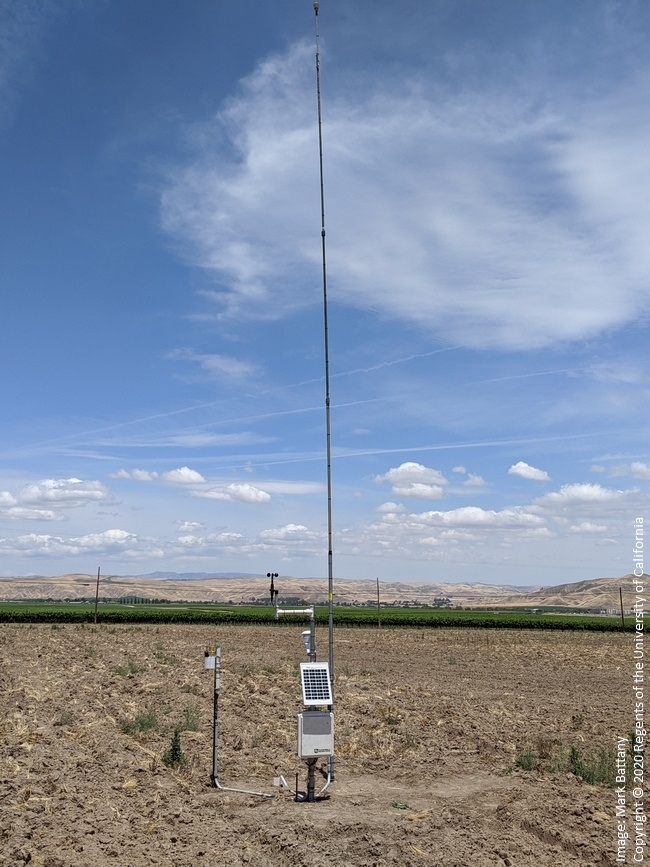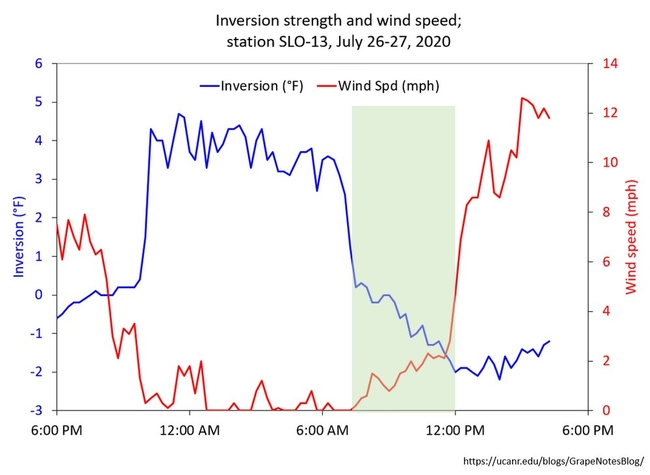This new project is bringing some unique and very useful weather data to San Luis Obispo County. Twenty weather stations are planned for the County; at this writing 12 are installed and operating. An additional twenty stations are also planned for Santa Barbara County, to be installed gradually after the San Luis Obispo network is completed.
These stations measure common variables of air temperature, humidity, rainfall, solar radiation, and wind speed, plus calculated variables such as the dew point and the reference evapotranspiration. They also have an additional air temperature sensor 30 feet above the ground to be able to measure the temperature inversion. This measurement is very useful to understand frost conditions and to better understand how we might respond to protect crops from frost damage. In particular the strength of the inversion can help us determine if wind machines will be useful during particular frost events; some earlier work describes this in detail (see the December 2011 Grape Notes).
The same inversion strength measurement at other times is also helpful to understand the potential for spray drift to occur. Pesticide labels often caution against spraying when the wind speed is too high and similarly caution against spraying when there is a temperature inversion; either of these conditions can lead to increased potential for drift. Measuring wind speed is fairly straightforward, however very few people have the ability to directly measure temperature inversion conditions when making spray application decisions. These weather stations can help us better understand the general regional patterns of both wind and inversion conditions, which can help us improve our understanding of when the optimal timing of sprays may occur.
With these weather stations the inversion strength is calculated by subtracting the air temperature measured at 5 feet from the air temperature measured at 30 feet. If the air temperature increases with height (an inversion), then the inversion strength value is positive. If the air temperature decreases with height (no inversion), then the inversion strength value is negative.
Figure 2 below provides an example of a common relationship between the inversion strength and the wind speed at an inland site in the summer when the sky was clear and there was little wind at night. During the night a strong inversion formed, which was possible because there was very little wind. During the daytime there was no inversion, and the wind speed increased throughout the day. If the decision to spray was based only on the wind speed information then this may have resulted in spraying at night; however the strong inversion at this time could increase the potential risk of spray drift. By including the inversion strength information in the decision process, the period from about 7 am until noon when there was no inversion and the wind speed was still relatively low appears more suitable; under these conditions the risk of drift would be expected to be less than during the previous night or later that same afternoon.
The above pattern can often occur in our inland areas in the summer, but at other times of the year the inversion may have a longer duration, beginning earlier in the evening and persisting later into the morning. This is due to the angle of the sun being lower in the sky at those times of the year, which reduces the amount of incoming solar radiation and thus reduces the warming of the ground surface and subsequently the warming of the air near the surface.
The data from this network of weather stations is being managed by the Western Weather Group. Many growers may already be familiar with their weather data websites as they manage numerous private weather station networks in California. The website for this San Luis Obispo County project is:
https://ucce-slo.westernweathergroup.com/
A similar separate website will be created for the future Santa Barbara County network.

